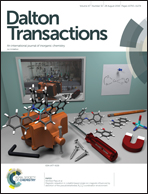Azine based smart probe for optical recognition and enrichment of Mo(vi )†
Abstract
Single crystal X-ray structure-characterized azine derivative (L) was explored for the selective detection of molybdenum (Mo(VI)) cations through green fluorescence emission. The Mo(VI) cation assisted inhibition of photo-induced electron transfer (PET) resulted in a 37-fold fluorescence enhancement via chelation enhanced fluorescence (CHEF) that allows detection of Mo(VI) with concentration as low as 2 × 10−9 M. The chelation of Mo(VI) cations by L has been confirmed by the single crystal X-ray structure of the resulting complex. The binding constant of L for Mo(VI) is fairly high (1.33 × 106 M−1). Moreover, L is very efficient for enrichment of Mo(VI) from aqueous solution. Density functional theoretical (DFT) studies substantiate the experimental results.



 Please wait while we load your content...
Please wait while we load your content...